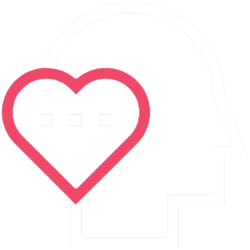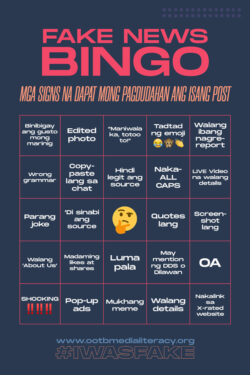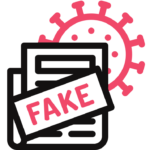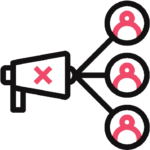MODULE C
Practicing Healthy Skepticism

Module Objectives
By the end of this module, the student will be able to…
- determine how personal biases influence one’s perception of information
- identify the tell-tale signs present in most mis-/disinformation
- acknowledge one’s emotional reactions to given issues
- foster healthy skepticism towards the self and the information environment
DepEd MELCs for MIL
- Discuss responsible use of media and information
- Discuss the implication of media and information to an individual and the society
- Analyze how the different dimensions are formally and informally produced, organized, and disseminated
Why should we keep our emotions in check when we are online?
HEADS UP! Read the following headlines. Imagine as if you’re seeing them on your social media feed. What reactions would you give for each headline?
Lunas sa COVID, natagpuan na!!! ALAMIN DITO
5 Filipinos die of COVID-19 in Saudi Arabia; at least 119 infected
Pilipinas kulelat nga ba sa laban kontra COVID-19?
It can be hard to admit to oneself and to others when you have fallen for false information. This is especially true when you realize that it was because you did not put much thought to it. Instead, you were just fueled by your emotions. Misleading stories spread like wildfire because they prey heavily on our strong feelings of anger, fear, or joy. To avoid this, you must pause, slow down, and try to switch off your emotions.
The first step in IWAS FAKE is to pause and calm down: [I]KALMA ANG SARILI.
Studies show that people remember information better when they appeal to their emotions. These are stories that make people angry, scared, anxious, or those that make them jump for joy. One perfect example of misinformation that banked on people’s fear is when social media personality DJ Loonyo hinted about the alleged ‘dangers’ of coronavirus mass testing. Through a Facebook livestream, he expressed fears over what one might be asked to drink or ingest in a ‘trial-and-error’ process for “mass testing”. His statement went viral and drew flak for spreading fear and misinformation about COVID-19 testing, which does not require ingestion nor is a trial-and-error process.
Another example is this clickbait story from tabloid Abante Tonite about a bill making religious mementos in hospitals optional. Its misleading headline states, “Hindi lahat Katoliko! Krus sa mga ospital pinapatanggal”. The story was shared on Facebook in multiple pages and groups, garnering “angry” reactions from many Facebook users. The headline purposefully misled the readers to think that the bill intends to ban religious mementos instead of simply making it optional.
Confirmation bias
Aside from our emotions, we also tend to accept information faster and easier when they confirm our existing views. This is called ‘confirmation bias’. The danger here is when we think something is true when we feel that it must be true. This is most applicable to misleading content — information that has some amount of truth to it rather than being entirely made up. If an online post is ‘partly true’ and you are already convinced by half of it, you may disregard that that post is also ‘partly false’ or, at the very least, incomplete.
If we encounter a post online that feels right to us and triggers our emotion, our tendency is to share it with others. So, the very first step is crucial: pause, calm down, and recognize your emotional response. This is called ’emotional skepticism’ or questioning your own emotional reactions to the messages around you.

Bonus: Other hidden biases
Aside from confirmation bias, there are many other hidden biases that influence one’s way of thinking. It is useful to be aware of these, too.
- Implicit bias (we associate two different things, which in our minds, are usually linked)
- Sunk-cost fallacy (the more time or emotions we invest into something, the more we want to keep investing in it)
- Anchoring bias (the first piece of information we hear tends to have more influence on us)
- Bandwagon effect (if a lot of people act or think in a certain way, we tend to act or think the same)
TWEET YOUR THOUGHTS. Everyone has a bias. What certain biases of yours do you think could affect your consumption of news and information? Tweet us at @ootbmedialit and use the hashtag #IWASFAKE.
FOR THE NEXT LESSON, you will learn about the second step in IWAS FAKE which involves keeping an eye on the red flags of mis- and dis-information.
How can we find a balance between trusting and doubting?
HEADS UP! List down your most trusted news and information sources. What makes these sources trustworthy for you?
From the previous lesson, you learned about the importance of keeping your emotions and your own biases in check. This is very crucial because most false and misleading contents are designed to target people’s emotions and hidden biases. Moreover, practicing self-reflection helps us avoid our own tendency to only see what we want to see. As we learn to be more aware of our emotions, we become better prepared to engage with the disinformation that surrounds us.
For this lesson, we continue with developing the attitude of maintaining healthy skepticism. This time, towards the infodemic. One of the main challenges presented by the infodemic is finding trustworthy sources amidst the information overload about the coronavirus pandemic. As a rule of thumb, keep in mind to always act with caution — the second step in IWAS FAKE: [W]AG BASTA MANINIWALA (Be skeptical).
Healthy Skepticism vs Cynicism
To be skeptical means to have an attitude of doubt, to be always questioning. This is a really important skill to have in the time of the infodemic, but too much of it can be unhealthy too. It can quickly slide into cynicism which is an attitude of scorn, negativity, and general distrust in people’s motives and integrity. When you see too much disinformation everywhere, it is easy to be disheartened and to develop hatred, and this is what we must strive to avoid. Remember that not all information is designed to deceive or manipulate. Our goal is to maintain the right amount of skepticism of the news we consume without sliding into the idea that good journalism does not exist.
How to Spot Potential Disinformation
One way to practice healthy skepticism is by being on the lookout for red flags or tell-tale signs. We do this a lot with COVID-19. If we want to know if someone might be infected by the coronavirus, we check for signs and symptoms like fever, fatigue, and dry cough. Like COVID-19, to detect disinformation involves looking for signs or red flags, too. These signs will help you act with more caution every time you go online.
It does not mean, however, that if you spot these signs in a particular material, it is already a piece of disinformation. Maintaining the right amount of skepticism means always keeping a room for error. Your gut feel may not be right all the time.
Another important strategy so that you can avoid cynicism is to learn to ask questions about ALL media messages, not just those with which you may disagree with. We must be aware of and open to questioning not only the biases of media producers but also our own biases. This way, we find the right balance between trusting and doubting.
TWEET YOUR THOUGHTS. Aside from the red flags listed here, what other reasons will make you doubtful of a certain piece of information? Tweet us at @ootbmedialit and use the hashtag #IWASFAKE.
THAT ENDS MODULE C. Are you ready to test your knowledge and practice your skills? Ask your teacher or us for the Module C worksheets.
* * *
FOR THE NEXT LESSON, you will learn about what it means to be a journalist and how the ‘discipline of verification’ can be very useful in this time of the infodemic.
Pop Quiz
#IWASFAKE Playlist 4: Cognitive Biases and Emotional Skepticism
#IWASFAKE Playlist 5: How to Spot and to Stop “Fake News”

© This learning resource is made available by Out of The Box Media Literacy Initiative under a Creative Commons Attribution-NonCommercial 4.0 International license (CC BY-NC 4.0). You can copy and redistribute the material, remix, transform or build upon it so long as you attribute #IWASFAKE as the original source. You may not use the material for commercial purposes. View detailed license information at creativecommons.org.





